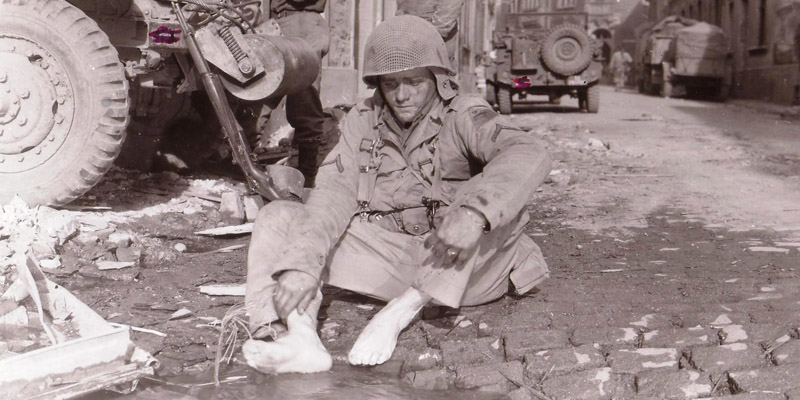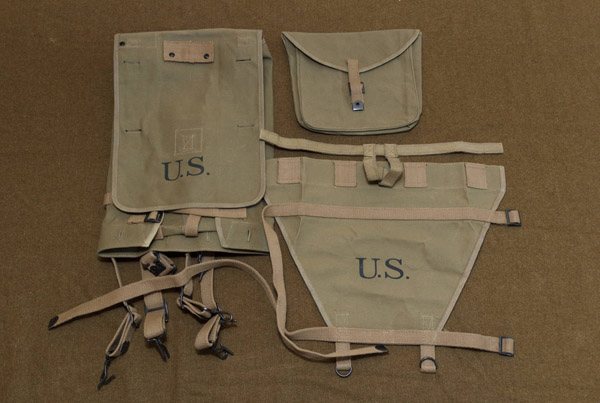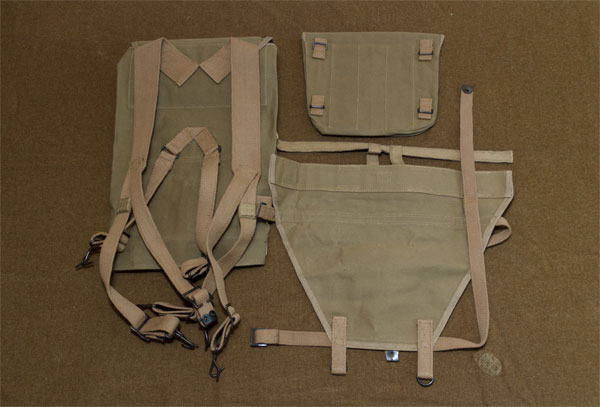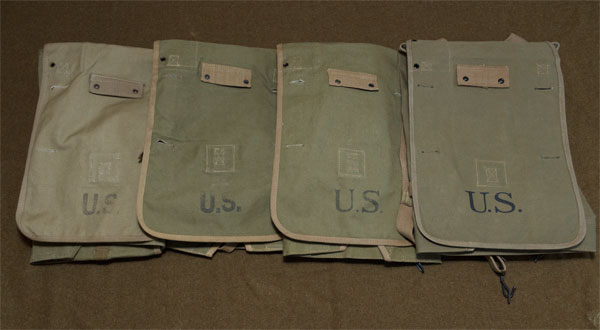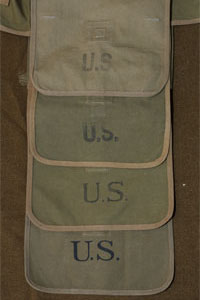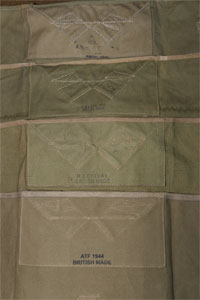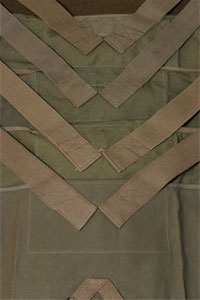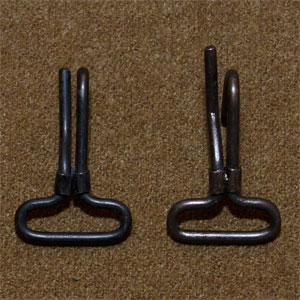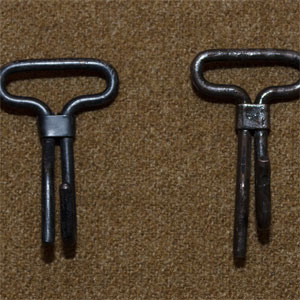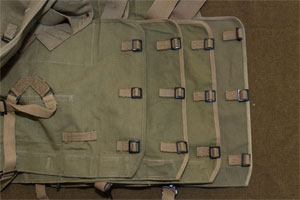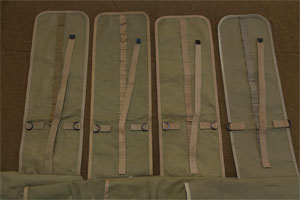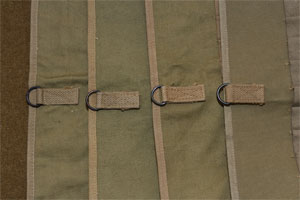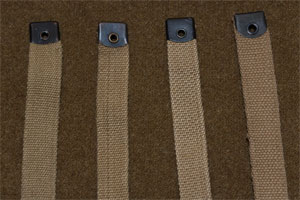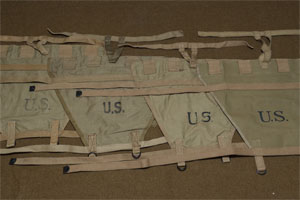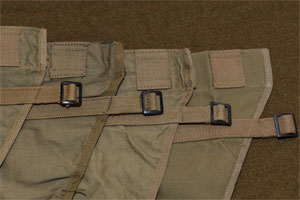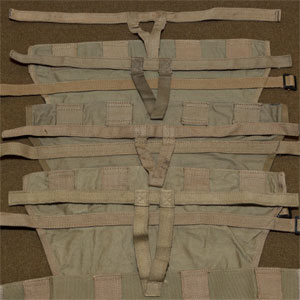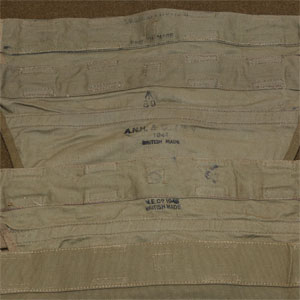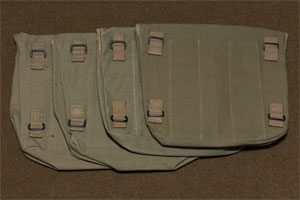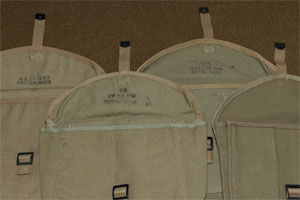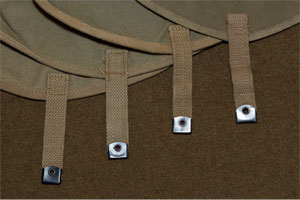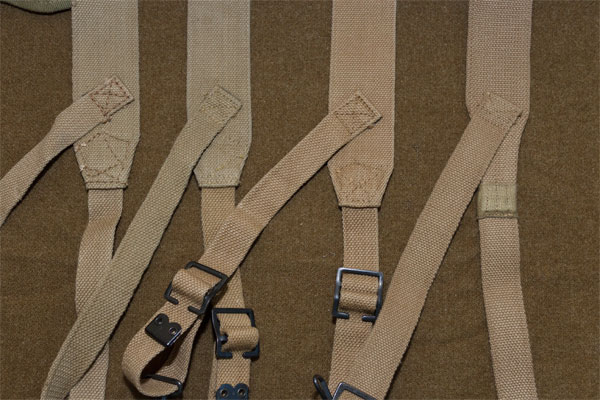At The Front M1928 Haversack - British Made
Review Date: 2/14/2015
Author: P.W. Browning
Location: Bendorf, Germany Date taken: March 25, 1945 Photographer: JM Helsop, Signal Corps. Courtesy of the National Archives and Records Administration
Background
During WWII the United States loaned billions of dollars in war material to the Allies. The beginning of what would become known as Reverse Lend Lease originated with the U.S. and British Empire trading blanket and sock supplies to avoid expensive and at that time, dangerous logistics. The U.S. Would need large amounts of these items in the MTO and ETO and England had a marked need for these in the PTO and CBI Theaters. This exchange quickly escalated to Reverse Lend Lease when in 1942 the U.S. Quartermaster Corps determined there were not enough U.S. assets able to produce the estimated 868,500,000 yards of hardy webbing needed to support the growing U.S. Army through the duration of the war. England quickly took advantage of this need, as a not only a way to utilize existing machinery and manufacturing capacity but to also pay back some of its substantial war debt. Ultimately, the British made several million uniform and field gear pieces for the U.S. Army. A quick selection from the U.S. Quartermaster shows the wide variety and significant volume of these unique pieces already delivered by December 31, 1943.
Belt, Cartridge, Cal. .30 Belt, Pistol Cover, Canteen, Dismounted Pouch, First Aid Packet Haversack (with Carrier, Meat Can) British Made Fieldgear can be difficult to identify in original photos. Some items, like Canteen Covers, are virtually indistinguishable in a black and white photograph. A few can be picked-out with careful observation of select features, such as the hooks on 28 Haversacks or the buckles on Musette Bags. Finally there were pieces of completely different construction, M1 Carbine Pouches for instance.
Photo From: The M1 Carbine in Normandy: A Case StudyExamining these pieces in person, one is quick to notice the difference in color. Canvas or Cotton Twill is often a much brighter and greener shade of OD than seen in U.S. manufactured equipment… think almost a drab version of Easter Grass Green. You still see shades close to OD#3, but much of the British Made gear has a green tint. Edging tape is typically a buff or flesh color Web strapping is found in colors identical to the British P37 gear, all the way to a golden tan color reminiscent of WWI U.S. Webbing. A couple notable features that, while strange, are consistent in British Made U.S. gear are the internal dividers on the British Made Musette Bags and the lining of the T-Handle Shovel Cover. The Musette Bag dividers are a linen, in the same color and weave of German Bread Bag material. The weirdest though, has to be the drab pink cloth used as the liner for the British Made T-Handel Shovel Covers.
Hardware can be found as identical copies of U.S. hardware, as British P37 hardware, or in some cases specially made hardware. Blackened bronze dominates, but you can find blued steel or in very rare instances, blackened or raw copper.
Markings are almost as varied as one finds in U.S. manufactured gear. The U.S. identifier marking occurs most often sans serif, but you can also find pieces marked in serif fonts, some identical to the U.S. domestic makers applied. Producing firm manufacturing marks look typically British, with most bearing Ltd. after a name. M.E.Co. for the Mills Equipment Company being one exception. Virtually all pieces are marked British Made, include a year date and Broad Arrow.
Special Note
To the best of my knowledge, no other company has reproduced U.S. British Made Fieldgear. One-off, handmade reproductions have existed since the 1990s, a few of excellent quality. When ATF hinted at making British Made reproduction U.S. field equipment, I was thrilled.
Cost & Ordering
Current cost on the U.S. British Made 28 Haversack is $89.99. They were placed on sale at least once, but I don't recall the reduced price. Ordering was simple and straightforward using ATFs website, eCommerce at its finest. Shipping was either same or next day via UPS Ground. As usual with ATF, the package arrived well packaged.
About the Review
All photographs were taken within about a 30 minute span on an original GI wool blanket. The ATF reproduction was photographed next to 3 original British Made U.S. 28 Haversacks of different manufacturers, all made in 1944 in excellent to near unissued condition. In the comparison shots, the ATF item is always at the far right, or if stacked vertically is at the bottom.
The Reproduction
First impressions out of the box... Wow!
Color
Nailed it! So happy Rollin didn’t succumb to the cult of the happy khaki! The canvas is of the noticeably greener shade found on Brit Made U.S. gear. Not as green or as bright as some extremes I have witnessed, but definitely greener and well within an acceptable range. Edging tape is buff as it should be and the webbing is on the golden side, all authentic colors and executed well. Bravo!
Markings
Meh. Disappointed ATF went with a serif font. While it is authentic, more British Made U.S. web gear drops the serif than includes it. Internal markings left much to be desired. ATF 1944, British Made. Rollin had a great opportunity to add a new fictitious manufacturer with a Limey sounding name to his repertoire, but totally blew it. We didn’t even get so much as a broad arrow. At least the manufacturers mark is relegated to the inside of the 1928 haversack, as is typical of the ones produced by the British. Side note, I would rather see any reproduction piece of equipment ATF makes marked Kirkman or Crawford over ATF.
Hardware
Truly amazing, would be hard to improve upon. Buckles seem to be blackened bronze, and webbing end tips appear to be blued steel. Best of all… instead of going the easy (yet acceptable) route with U.S. style clips, Rollin had the unique open hook design duplicated. Material seems to be bronze or brass with a piece of copper used to crimp them. All blackened and represent a near perfect copy of the originals.
Pattern
Not much to comment on, ATF has captured accurate dimensions as well as the weight of the canvas and webbing.
Worth mentioning is the attention to detail on some of the unique British Made features, such as the all web construction of the Pack Carrier. The British Made 28 Pack Carrier/Tail omitted the detachable leather fastening strap in exchange for a permanently fixed web replacement. Arguably a better design, that ATF reproduces perfectly.
The Meat Can Pouch is also an exact duplicate in material, color, pattern and construction. Used a few times and the Pack Tails and Meat Can Pouches will be hard to distinguish from originals. Again, Bravo!
The only feature of construction that jumped out at me when comparing the ATF Reproduction British Made U.S. 28 Haversack to originals is the method used to taper down the shoulder strap. On the three originals I have, all managed this by a special weaving technique and folding the webbing, where the ATF piece appears to be either an unfinished weave or multi-piece construction covered by a section of cloth or binding tape. By no means are the samples of originals in the article a representation of all British Made U.S. 28 Haversacks, and admittedly it wasn’t something I noticed until taking the comparison photos. It is simply a difference based on the originals I own.
ConclusionsThis is a very well made reproduction of a piece of fieldgear that's underrepresented today in WWII reenacting. I personally think it's great ATF took a chance on making reproduction British Made U.S. gear, and that it was executed so successfully with such a high degree of authenticity. I understand this is being treated at ATF as an experiment and should sales not do well, it's likely we won't see these restocked.
Pros-Only Reproduction of a growingly more expensive itemBritish Made U.S. fieldgear is underrepresented in reenactingColors are outstandingHardware is near perfectConstruction quality feels excellentU.S. markings are OK, would have preferred sans serif
Cons-Manufacturer markings stink, none would have been betterPossible pattern improvisation on shoulder strapsIt's a 1928 Haversack, damn these things suck
ReferencesWD: British-Made US Army Clothing and EquipmentOverlord Publishing 2014, Ben Major
90th IDPG Reviews



